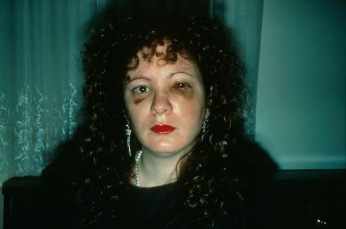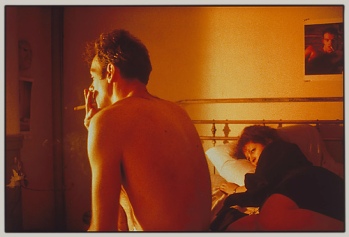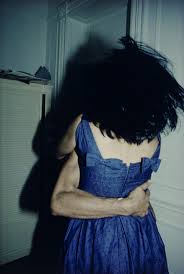 Last week I visited at the gallery H2O in Barcelona Gloria Gimenez photo exhibition. In her black and white series Actor’s made in 1992 she expressed interest in the rituals that characterize the different social groups in contemporary society. In these photographs I found some connections with the work of Nan Goldin (Washington DC 1953) I personally esteem as one of the most important contemporary artists. When looking in my library I found the catalogue of the exhibition dedicated to the “Five from Boston” which was organized in 1998 at the Hamburger Kunsthalle. This presentation, made by Dorte Zbikowski, speaks about Nan Goldin, one of the five photographers. I have translated passages that transmits all the value and relevance of the work of this artist.
Last week I visited at the gallery H2O in Barcelona Gloria Gimenez photo exhibition. In her black and white series Actor’s made in 1992 she expressed interest in the rituals that characterize the different social groups in contemporary society. In these photographs I found some connections with the work of Nan Goldin (Washington DC 1953) I personally esteem as one of the most important contemporary artists. When looking in my library I found the catalogue of the exhibition dedicated to the “Five from Boston” which was organized in 1998 at the Hamburger Kunsthalle. This presentation, made by Dorte Zbikowski, speaks about Nan Goldin, one of the five photographers. I have translated passages that transmits all the value and relevance of the work of this artist.
Nan Goldin think of the camera as a part of her body, as a veritable eye that stores impressions and experiences. For her, photographs have become “a voice that would not be censored, silenced or lost, that would not disappear”.
She began to take photographs when the memory of her older sister, who had committed suicide, began to fade.
At the age of fourteen, Goldin turned from her parents and siblings and sought a new community among her friends. She accompanied this steadily growing “family” with her camera in all circumstances of their lives and occasionally called her work her “visual diary” – “My life is my work”.
 In her self-portrait she uses the camera “to get under my skin again, to get to know my face and my environment anew”. She saw herself in a serious battered state, her face swollen and eyes bloodshot, but in her positively defiant bright-red, shiny lipstick there is a power of resistance that admits no trace of self-pity in spite of the clear demonstration of outward and inward injury.
In her self-portrait she uses the camera “to get under my skin again, to get to know my face and my environment anew”. She saw herself in a serious battered state, her face swollen and eyes bloodshot, but in her positively defiant bright-red, shiny lipstick there is a power of resistance that admits no trace of self-pity in spite of the clear demonstration of outward and inward injury.
Many of Goldin’s pictures are photographs from the life of fringe groups. Nan Goldin says she not only belongs to them but admires them too. She has known violence, taken drugs, lived in the homosexual and transvestite scene and lost friends of AIDS: a life in the midst of glamour, self-destruction and death.
Goldin photographs only those friends who have given their consent: “At the time when I make the pictures there is a complicity, a collaboration … So it’s later that the person may feel vulnerable and exposed. And in some cases I take the pictures out of circulation.” This shows how Goldin respects her models’ privacy, even though she invades it pretty thoroughly too with the pictures’ titles, in which names, place and date are recorded.
She encouraged her friends to be themselves. Or she gave them the opportunity to discover their identity in role-play in front of the camera. But Goldin never imposes her own ideas on her models.
 In her photographs Goldin does not just tell the private story of how she and her friends developed from minors to self-confident adults or found their identity. She tells of the dreams to becoming someone different, such as a star of the world of cinema and fashion magazines which compete for attention through scenes of sex and violence.
In her photographs Goldin does not just tell the private story of how she and her friends developed from minors to self-confident adults or found their identity. She tells of the dreams to becoming someone different, such as a star of the world of cinema and fashion magazines which compete for attention through scenes of sex and violence.
Goldin’s friend imitate the behavior of stars and models in front of the camera so as to borrow something of their aura. That means that not only the photographs but also the players are inspired by the media. At the same time, the photographs are a declaration of their escape from a life of social conventions and of their sexual masquerade.
In the early seventies Goldin made friends with the transvestites. She later collected the pictures from this milieu in the book The other side. It shows a glittery world of extravagant dresses and poses. But Goldin photographed the transvestites not only in their weekly beauty competitions but also privately in their everyday clothes and “dressing-up”. Goldin accepts them as they see themselves and want be seen by the others. “I had enormous respect for the courage my friends had in recreating themselves according to their fantasies”.
In her main work from the eighties, the Ballad of Sexual dependency, Goldin depicts in a show of hundreds of slides the development of women and men who in their struggle for self-determination have abandoned bourgeois ways. Euphoria and depression, hunger for life and the fear of death are expressed in the insatiable quest for the body of the other. With unremitted directness Goldin continually shows nudes washing, bathing or making love. But they display no weakness. Artist  and viewer openly confront each other. Sexuality and emotions are revealed by the photographer, but equally are surrendered by the models.
and viewer openly confront each other. Sexuality and emotions are revealed by the photographer, but equally are surrendered by the models.
Time and again Goldin enhances the power of her pictures by linking individual photographs to form complex series, such as the shots of her friend Cookie Muller that were taken over several years. For the book A double life she, together with David Armstrong, assembling a selection as a testament of friendship. The slides shows are especially forceful, and she has enlarged and re-arranged these for each presentation so as to keep up with changes in mood, feeling, impressions and memories. Goldin says, “I don’t believe in the single portrait. I believe only in the accumulation of portraits as a representation of a person. Because I think people are really complex”.
The same is true for reality.